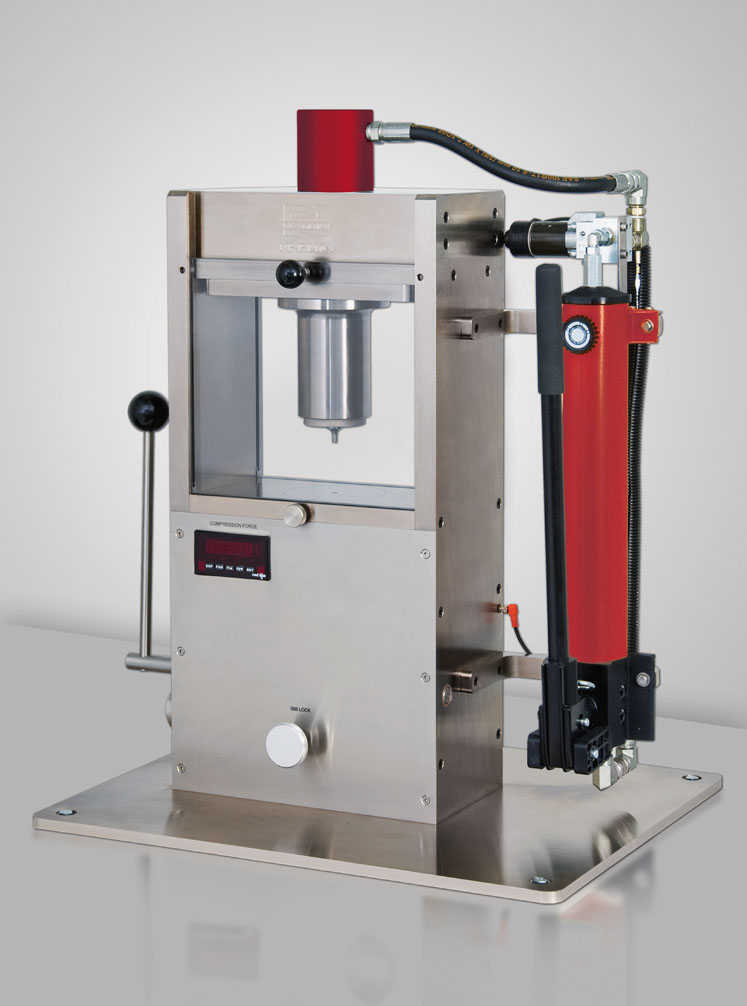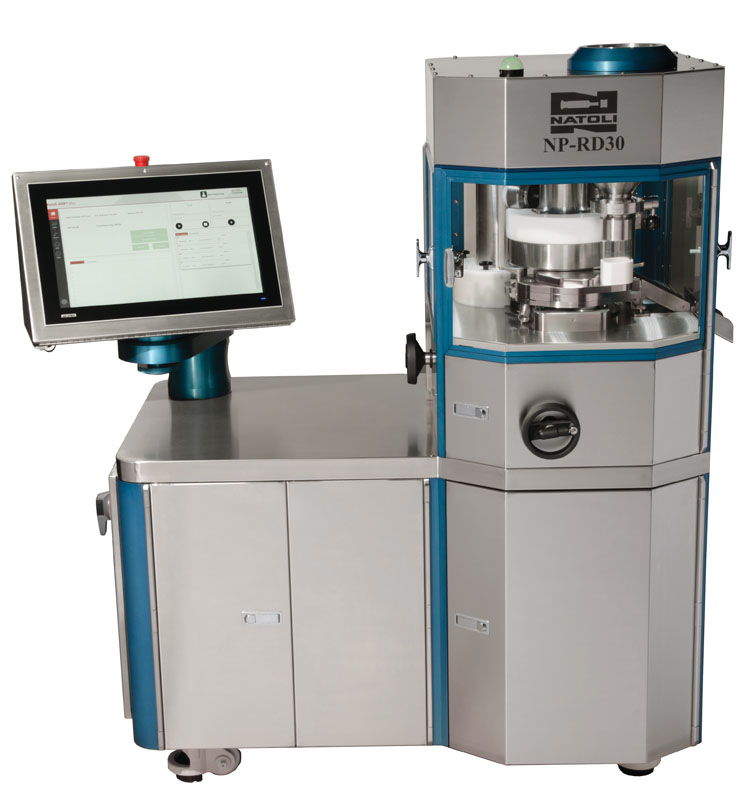All tablet presses employ the same basic operating principle. They compact a formulation of granular or powdered ingredients within a die between two punches. At any scale, the tablet press applies significant mechanical loads to the formulation during production … and the conditions created by these loads determine the success or failure of the tableting process.
It’s important to understand the forces acting on the formulation during tableting because any changes in applied pressure can affect other variables. An instrumented research and development (R&D) tablet press can help developers to analyse these forces and better understand the material’s behaviour prior to scale-up.
Tablet press instrumentation system components
A quality instrumentation system is critical to ensuring accurate and actionable data. A software system can display incorrect results just as attractively as it displays correct results, and imprecise data can lead to costly scale-up issues. Collecting accurate and actionable data requires three vital components: the force transducer, the signal conditioner and the user interface software.
Force transducer: a transducer is a device that converts energy from one form into another. On an R&D machine, the press applies mechanical force to the transducer during operation and the transducer generates a proportional electrical output. The transducer’s design and placement are critical to ensure that the device responds only to the force that it is intended to measure.
For example, a pre- or main compression transducer is designed to measure the force that is being applied by the punch head to the compression roller. The roll pin that supports the roller can be manufactured with strain gauges. The material of the roll pin or spring element (the area where the strain gauge is applied) is also essential and is dependent on the expected force range.
The force range of the main compression event is typically much higher than the force range expected for precompression. The spring element’s elastic modulus, or the slope of its stress-strain curve, is important for proper reporting. The transducer’s response should be sensitive and linear throughout its range and show minimal hysteresis, good thermal stability and an acceptable return to zero when the load is removed.
Signal conditioner: the function of the signal conditioner is to amplify the transducer’s small millivolt signal. This assembly requires a power supply, an amplifier, an analogue-to-digital converter and filters. The power supply is the source of excitation to the transducer.
Historically, power supplies can be noisy and tend to drift; today’s power supplies are, however, much more stable. It is still prudent to measure the incoming voltage before sampling the voltage from the sensor. Ratiometric measurement is an accurate way to read the sensor’s output, independent of the power supply’s voltage. The sensor output voltage is normalised by dividing the output of the applied voltage and is expressed in millivolts per volt applied.
The amplifier takes the small millivolt signal and may amplify it up to 100–1000 times. This amplification is needed to convert the analogue signal to a digital signal. The analogue-to-digital converter will convert the incoming analogue signal to a series of digital numbers to enable large quantities of data to be analysed.
Filters are used to remove unwanted analogue noise signals that may originate from other machines in the room.
User interface software: the user interface software monitors, records and organises the large amount of real-time in-process data generated by the sensors. Some software packages offer graphical plots to evaluate a formulation’s tabletability, compressibility, compactibility and scalability profiles.
R&D tablet presses
Scientists use three main types of tablet presses to develop pharmaceutical and nutraceutical tablets: single-station presses, compaction emulators and rotary presses. Single-station tablet presses are typically used during the initial stages of R&D because they require the smallest amount of material.

Figure 1: An example of a single-station tablet press (NP-RD10A) that uses single-ended hydraulic hand-pump compression
There are many different single-station tablet press designs, including eccentric, hydraulic hand-pump and automatic simulators driven mechanically or with hydraulics. Figure 1 shows an example of a single-station tablet press that uses single-ended hydraulic hand-pump compression. Single-station presses can be designed for single- or double-ended compression.
A single-ended compression system applies the load from the upper punch only; the lower punch receives only the force that’s transmitted through the powder bed and die wall friction. A double-ended compression system applies the load from both the upper and lower punches.
Double-ended compression is comparable with the compression on a rotary tablet press, which uses compression rollers to cause both the upper and lower punches to travel into the die to compact the material.
Single-station tablet presses that use single-ended compression provide valuable information if both the upper and lower punch assemblies are instrumented with force sensors. For example, if the lower punch force is equal to or greater than 90% of the upper punch force, then you can assume that there is very little friction in the die during compaction.
This information can be used to select the appropriate excipients for a material with inherent lubricating properties. By contrast, if the lower punch is not receiving a high percentage of the force applied to the upper punch, the formulation may require a lubricant or other excipient with lubricating properties.
The single-ended compression system is a valuable tool during the formulation process but is not desirable in a manufacturing environment; double-ended compression provides a more uniform tablet density and, ultimately, a more robust tablet.
A single-station tablet press allows the use of displacement sensors to measure the movements of the upper and lower punches in real-time. With proper calibration and machine compliance correction factors, operators can evaluate force displacement profiles or work curves. With a very limited amount of material, the press can provide data on the elastic nature of the material.
Materials that exhibit high elasticity often result in insufficient tablet hardness or even capping and lamination problems. Displacement measures can also provide Heckel and Kawakita plots, which also characterise a material’s deformation properties, including elasticity, plasticity and brittleness.
All this information can be evaluated and proactively implemented during formulation, resulting in a shorter R&D phase and more efficient tablet production.
Another instrument that can be easily installed on a single-station tablet press is a radial die wall sensor. This sensor measures the radial force on the die wall resulting from the axial force applied to the formulation by the punches, as well as the residual radial force remaining after the upper punch is released from the compaction event (but prior to ejection of the tablet). Die wall monitoring is a valuable tool for characterising compaction materials and detecting die wall friction phenomena.
Compaction emulators
A compaction emulator can also be used during a tablet’s R&D phase. A compaction emulator is designed to match the compression times of a high-speed production rotary tablet press but is instrumented to obtain the benefits of a single-station R&D tablet press.
Figure 2 shows an example of a Presster compaction emulator, which mimics the compression times of a high-speed production rotary tablet press but is instrumented to provide the same data as a single-station R&D tablet press.
Rotary tablet presses
The next step in the development process is to transfer the product to an instrumented small-scale rotary tablet press. These machines are scaled-down versions of production-scale rotary tablet presses, so they require just a few hundred grammes of material to provide data. This allows researchers to evaluate a formulation’s behaviour throughout the complete rotary press cycle and generate data such as compaction profiles and strain-rate scalability studies.
The instrumentation on an R&D rotary tablet press includes pre- and main compression forces, ejection force and take-off sticking force. An example of an instrumented R&D rotary tablet press, such as the NP-RD30, is shown in Figure 3.
The pre- and main compression readings play a significant role when analysing the consolidation and compaction phase, when entrapped air is removed from the formulation, particles are deformed and interparticle bonding occurs. At this stage, it is critical to understand the product’s failure limits with respect to tablet strength, capping and lamination, friability, disintegration and dissolution time.
After the compression and decompression stages, the tablet is ejected from the die. The ejection force is a product of the residual radial die-wall force and the coefficient of friction between the compacted tablet and the die wall. High ejection forces can cause premature wear to the punches or press cams, as well as tablet quality issues.

Figure 3: An instrumented R&D rotary tablet press such as the NP-RD30 shown here allows researchers to evaluate a formulation’s behaviour throughout the complete rotary press cycle
The most common remedy for high ejection forces is increasing the amount of powdered lubricant (typically magnesium stearate) in the blend. The amount of lubricant should be optimised, as too much lubricant can cause tablet capping and friability and increase disintegration times.
You can optimise the lubricant amount by conducting a compaction profile study in which you make a number of tablets using incrementally increasing compression forces and record the ejection forces for each. To ensure accurate data, the ejection transducer must be a “full travel” design, especially if the press is one on which you change the tablet thickness and compression force by adjusting the lower compression roller.
A full travel ejection design will provide an accurate millivolt signal across the entire range of the ejection sensor. Some press manufacturers use a button load cell that only captures the data in one small area, which will report inaccurate data for a compaction profile study.
The last stage of the tableting cycle is the tablet take-off or removal from the lower punch face. Take-off is the phase when tablet sticking or picking may occur. An instrumented take-off bar will measure the force required to release the tablet from the lower punch face and detect early signs of sticking.
The force required is normally in the range of a few newtons, so this requires a very sensitive sensor, typically manufactured with a material that exhibits a very low elastic modulus (such as aluminium). Additionally, a semiconductor strain gauge provides more than 20 times the sensitivity output of a standard foil strain gauge.
Conclusion
Although they may appear simple, tablets are complex drug delivery systems. Underestimating the importance of their design, formulation and manufacture invites significant production difficulties at some stage of development or product life. Instrumented R&D tablet presses and data-collecting software packages are critical for the success of a tablet manufacturing process.





